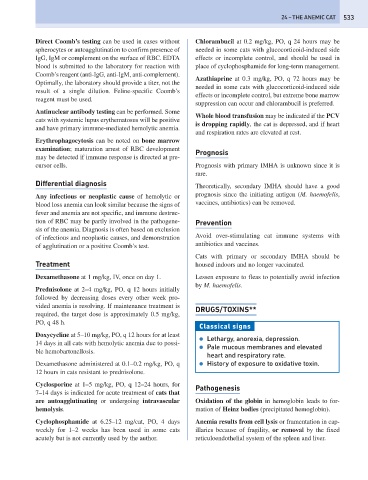Page 541 - Problem-Based Feline Medicine
P. 541
24 – THE ANEMIC CAT 533
Direct Coomb’s testing can be used in cases without Chlorambucil at 0.2 mg/kg, PO, q 24 hours may be
spherocytes or autoagglutination to confirm presence of needed in some cats with glucocorticoid-induced side
IgG, IgM or complement on the surface of RBC. EDTA effects or incomplete control, and should be used in
blood is submitted to the laboratory for reaction with place of cyclophosphamide for long-term management.
Coomb’s reagent (anti-IgG, anti-IgM, anti-complement).
Azathiaprine at 0.3 mg/kg, PO, q 72 hours may be
Optimally, the laboratory should provide a titer, not the
needed in some cats with glucocorticoid-induced side
result of a single dilution. Feline-specific Coomb’s
effects or incomplete control, but extreme bone marrow
reagent must be used.
suppression can occur and chlorambucil is preferred.
Antinuclear antibody testing can be performed. Some
Whole blood transfusion may be indicated if the PCV
cats with systemic lupus erythematosus will be positive
is dropping rapidly, the cat is depressed, and if heart
and have primary immune-mediated hemolytic anemia.
and respiration rates are elevated at rest.
Erythrophagocytosis can be noted on bone marrow
examination; maturation arrest of RBC development
Prognosis
may be detected if immune response is directed at pre-
cursor cells. Prognosis with primary IMHA is unknown since it is
rare.
Differential diagnosis Theoretically, secondary IMHA should have a good
Any infectious or neoplastic cause of hemolytic or prognosis since the initiating antigen (M. haemofelis,
blood loss anemia can look similar because the signs of vaccines, antibiotics) can be removed.
fever and anemia are not specific, and immune destruc-
tion of RBC may be partly involved in the pathogene- Prevention
sis of the anemia. Diagnosis is often based on exclusion
of infectious and neoplastic causes, and demonstration Avoid over-stimulating cat immune systems with
of agglutination or a positive Coomb’s test. antibiotics and vaccines.
Cats with primary or secondary IMHA should be
Treatment housed indoors and no longer vaccinated.
Dexamethasone at 1 mg/kg, IV, once on day 1. Lessen exposure to fleas to potentially avoid infection
by M. haemofelis.
Prednisolone at 2–4 mg/kg, PO, q 12 hours initially
followed by decreasing doses every other week pro-
vided anemia is resolving. If maintenance treatment is
DRUGS/TOXINS**
required, the target dose is approximately 0.5 mg/kg,
PO, q 48 h.
Classical signs
Doxycycline at 5–10 mg/kg, PO, q 12 hours for at least
● Lethargy, anorexia, depression.
14 days in all cats with hemolytic anemia due to possi-
● Pale mucous membranes and elevated
ble hemobartonellosis.
heart and respiratory rate.
Dexamethasone administered at 0.1–0.2 mg/kg, PO, q ● History of exposure to oxidative toxin.
12 hours in cats resistant to prednisolone.
Cyclosporine at 1–5 mg/kg, PO, q 12–24 hours, for
Pathogenesis
7–14 days is indicated for acute treatment of cats that
are autoagglutinating or undergoing intravascular Oxidation of the globin in hemoglobin leads to for-
hemolysis. mation of Heinz bodies (precipitated hemoglobin).
Cyclophosphamide at 6.25–12 mg/cat, PO, 4 days Anemia results from cell lysis or framentation in cap-
weekly for 1–2 weeks has been used in some cats illaries because of fragility, or removal by the fixed
acutely but is not currently used by the author. reticuloendothelial system of the spleen and liver.

